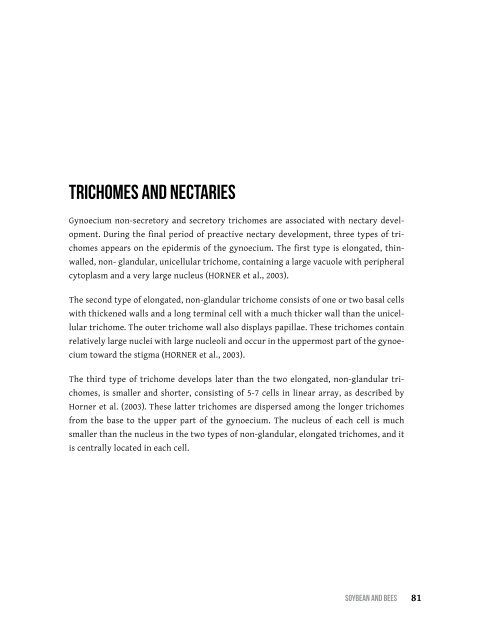Soybean and Bees
Create successful ePaper yourself
Turn your PDF publications into a flip-book with our unique Google optimized e-Paper software.
Trichomes <strong>and</strong> nectaries<br />
Gynoecium non-secretory <strong>and</strong> secretory trichomes are associated with nectary development.<br />
During the final period of preactive nectary development, three types of trichomes<br />
appears on the epidermis of the gynoecium. The first type is elongated, thinwalled,<br />
non- gl<strong>and</strong>ular, unicellular trichome, containing a large vacuole with peripheral<br />
cytoplasm <strong>and</strong> a very large nucleus (Horner et al., 2003).<br />
The second type of elongated, non-gl<strong>and</strong>ular trichome consists of one or two basal cells<br />
with thickened walls <strong>and</strong> a long terminal cell with a much thicker wall than the unicellular<br />
trichome. The outer trichome wall also displays papillae. These trichomes contain<br />
relatively large nuclei with large nucleoli <strong>and</strong> occur in the uppermost part of the gynoecium<br />
toward the stigma (Horner et al., 2003).<br />
The third type of trichome develops later than the two elongated, non-gl<strong>and</strong>ular trichomes,<br />
is smaller <strong>and</strong> shorter, consisting of 5-7 cells in linear array, as described by<br />
Horner et al. (2003). These latter trichomes are dispersed among the longer trichomes<br />
from the base to the upper part of the gynoecium. The nucleus of each cell is much<br />
smaller than the nucleus in the two types of non-gl<strong>and</strong>ular, elongated trichomes, <strong>and</strong> it<br />
is centrally located in each cell.<br />
SoybeAn <strong>and</strong> bees<br />
81


